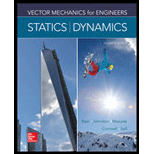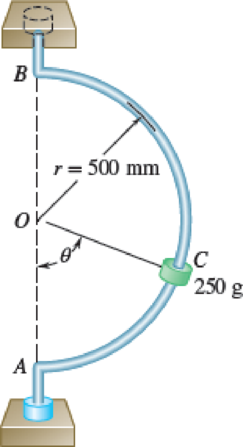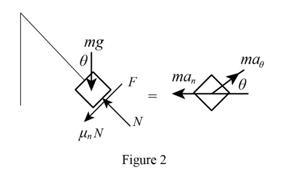
Concept explainers
A small 250-g collar C can slide on a semicircular rod which is made to rotate about the vertical AB at a constant rate of 7.5 rad/s. Knowing that the coefficients of friction are μs = 0.25 and μk = 0.20, indicate whether the collar will slide on the rod if it is released in the position corresponding to (a) θ = 75°, (b) θ = 40°. Also, determine the magnitude and direction of the friction force exerted on the collar immediately after release.
Fig. P12.64 and P12.65

(a)
Indicate whether the collar will slide on the rod if it is released in the position corresponding to angle
Find the magnitude and direction of the friction force exerted on the collar immediately after release.
Answer to Problem 12.65P
The collar does not slide on the rod if it is released in the position corresponding to angle
The magnitude and direction of the friction force exerted on the collar immediately after release is 0.611 N.
Explanation of Solution
Given information:
The mass of collar (m) is 250 g.
The speed of rotation of semi-circular rod
The radius (r) of semicircular rod is 500 mm.
The coefficient of static friction
The coefficient of kinetic friction
Calculation:
The collar will not slide. Therefore the collar moves at constant speed.
Find the equation of radius of circle for constant rotation.
Find the equation of speed of semicircular rod for constant rotation:
Find the equation of normal acceleration
Substitute
Substitute
Sketch the free body diagram and kinetic diagram of the collar C as shown in Figure (1).

Refer Figure (1):
Find the normal force (N) on the collar.
Apply Newton’s law of equation along x-axis.
Substitute
Substitute 250 g for m,
Find the frictional force (F) using Newton’s law of equation:
Apply Newton’s law of equation along y-axis.
Substitute
Substitute 250 g for m,
Find the frictional force using general equation:
Substitute 0.25 for
The frictional force
Thus, the magnitude and direction of the friction force exerted on the collar immediately after release is 0.611 N.
(b)
Indicate whether the collar will slide on the rod if it is released in the position corresponding to angle
Find the magnitude and direction of the friction force exerted on the collar immediately after release.
Answer to Problem 12.65P
The collar does not slide on the rod if it is released in the position corresponding to angle
The magnitude and direction of the friction force exerted on the collar immediately after release is 0.957 N.
Explanation of Solution
Calculation:
Find the normal force (N) on the collar using Equation (1):
Substitute 250 g for m,
Find the frictional force (F) using Equation (2):
Substitute 250 g for m,
Find the frictional force using general equation:
Substitute 0.25 for
The frictional force
Sketch the free body diagram and kinetic diagram of the collar C which is sliding as shown in Figure (2).

Refer Figure 2:
Find the normal force (N) on the collar.
Apply Newton’s law of equation along x-axis.
Substitute
Substitute 250 g for m,
Find the magnitude and direction of the friction force
Substitute 0.20 for
Thus, the magnitude and direction of the friction force exerted on the collar immediately after release is 0.957 N.
Want to see more full solutions like this?
Chapter 12 Solutions
Vector Mechanics for Engineers: Statics and Dynamics
Additional Engineering Textbook Solutions
Starting Out with C++ from Control Structures to Objects (9th Edition)
Problem Solving with C++ (10th Edition)
Mechanics of Materials (10th Edition)
Fluid Mechanics: Fundamentals and Applications
SURVEY OF OPERATING SYSTEMS
Database Concepts (8th Edition)
- Solve this problem and show all of the workarrow_forwardaversity of Baoyion aculty of Engineering-AIMusyab Automobile Eng. Dep. Year: 2022-2023, st Course, 1st Attempt Stage: 3rd Subject: Heat Transfer I Date: 2023\01\23- Monday Time: 3 Hours Q4: A thick slab of copper initially at a uniform temperature of 20°C is suddenly exposed to radiation at one surface such that the net heat flux is maintained at a constant value of 3×105 W/m². Using the explicit finite-difference techniques with a space increment of Ax = = 75 mm, determine the temperature at the irradiated surface and at an interior point that is 150 mm from the surface after 2 min have elapsed. Q5: (12.5 M) A) A steel bar 2.5 cm square and 7.5 cm long is initially at a temperature of 250°C. It is immersed in a tank of oil maintained at 30°C. The heat-transfer coefficient is 570 W/m². C. Calculate the temperature in the center of the bar after 3 min. B) Air at 90°C and atmospheric pressure flows over a horizontal flat plate at 60 m/s. The plate is 60 cm square and is maintained at a…arrow_forwardUniversity of Baby on Faculty of Engineering-AIMusyab Automobile Eng. Dep. Year: 2022-2023. 1 Course, 1" Attempt Stage 3 Subject Heat Transfer I Date: 2023 01 23- Monday Time: 3 Hours Notes: Q1: • • Answer four questions only Use Troles and Appendices A) A flat wall is exposed to an environmental temperature of 38°C. The wall is covered with a layer of insulation 2.5 cm thick whose thermal conductivity is 1.4 W/m. C, and the temperature of the wall on the inside of the insulation is 315°C. The wall loses heat to the environment by convection. Compute the value of the convection heat-transfer coefficient that must be maintained on the outer surface of the insulation to ensure that the outer-surface temperature does not exceed 41°C. B) A vertical square plate, 30 cm on a side, is maintained at 50°C and exposed to room air at 20°C. The surface emissivity is 0.8. Calculate the total heat lost by both sides of the plate. (12.5 M) Q2: An aluminum fin 1.5 mm thick is placed on a circular tube…arrow_forward
- Solve this and show all of the workarrow_forwardNeed helparrow_forwardY F1 α В X F2 You and your friends are planning to move the log. The log. needs to be moved straight in the x-axis direction and it takes a combined force of 2.9 kN. You (F1) are able to exert 610 N at a = 32°. What magnitude (F2) and direction (B) do you needs your friends to pull? Your friends had to pull at: magnitude in Newton, F2 = direction in degrees, ẞ = N degarrow_forward
 Elements Of ElectromagneticsMechanical EngineeringISBN:9780190698614Author:Sadiku, Matthew N. O.Publisher:Oxford University Press
Elements Of ElectromagneticsMechanical EngineeringISBN:9780190698614Author:Sadiku, Matthew N. O.Publisher:Oxford University Press Mechanics of Materials (10th Edition)Mechanical EngineeringISBN:9780134319650Author:Russell C. HibbelerPublisher:PEARSON
Mechanics of Materials (10th Edition)Mechanical EngineeringISBN:9780134319650Author:Russell C. HibbelerPublisher:PEARSON Thermodynamics: An Engineering ApproachMechanical EngineeringISBN:9781259822674Author:Yunus A. Cengel Dr., Michael A. BolesPublisher:McGraw-Hill Education
Thermodynamics: An Engineering ApproachMechanical EngineeringISBN:9781259822674Author:Yunus A. Cengel Dr., Michael A. BolesPublisher:McGraw-Hill Education Control Systems EngineeringMechanical EngineeringISBN:9781118170519Author:Norman S. NisePublisher:WILEY
Control Systems EngineeringMechanical EngineeringISBN:9781118170519Author:Norman S. NisePublisher:WILEY Mechanics of Materials (MindTap Course List)Mechanical EngineeringISBN:9781337093347Author:Barry J. Goodno, James M. GerePublisher:Cengage Learning
Mechanics of Materials (MindTap Course List)Mechanical EngineeringISBN:9781337093347Author:Barry J. Goodno, James M. GerePublisher:Cengage Learning Engineering Mechanics: StaticsMechanical EngineeringISBN:9781118807330Author:James L. Meriam, L. G. Kraige, J. N. BoltonPublisher:WILEY
Engineering Mechanics: StaticsMechanical EngineeringISBN:9781118807330Author:James L. Meriam, L. G. Kraige, J. N. BoltonPublisher:WILEY





